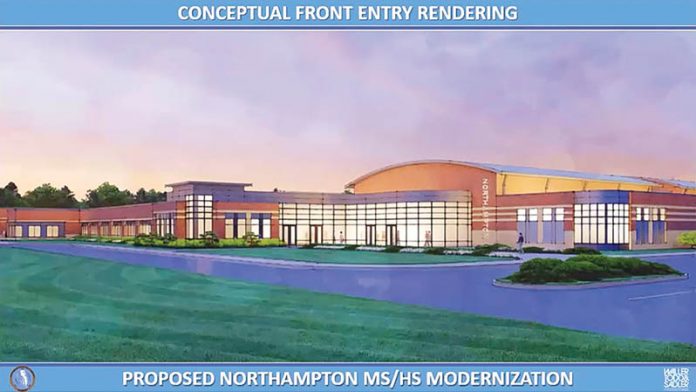
By Stefanie Jackson – The cost of Northampton High School renovations and construction that will transform it into a modern middle and high school complex has increased by more than $9 million in the last nine months, from about $39 million in October 2020 to nearly $48 million in July 2021.
The new price tag partly reflects construction and material costs that increased sharply due to slowed production during the COVID-19 pandemic, but at least one person at the Aug. 10 Northampton supervisors meeting believed that the additional, non-construction costs were overestimated.
Project construction costs rose from nearly $31 million to more than $38 million, with which supervisors did not disagree.
However, including a 5% contingency and 20% for the “soft costs” of architecture and engineering services, construction management, equipment, and furniture totaled more than $9.5 million in additional expenses, which is “off the charts,” said Supervisor John Coker.
He acknowledged that the services such as construction management were necessary but “that number’s just way too big,” he said of the additional project costs.
Coker said the estimated project cost started at $25 million and is now almost $50 million. “We can’t spend that much money.”
Northampton schools Chief Financial Officer Brook Thomas explained several examples of how construction costs had increased since October 2020.
More than $3.5 million in extras had been included in the project design, including approximately:
- $1.9 million to add about 7,500 square feet to the high school.
- $425,000 for culinary arts equipment.
- $346,000 more for the cost of the geothermal heating and cooling system.
- $209,000 to replace 1,000-seat bleachers in the high school gym.
- $210,000 for six operable glass partitions in the middle school.
- $200,000 for eight operable markerboard partitions in the middle school.
- $146,000 for inclusive restrooms near the auditorium and cafeteria.
- $133,000 more for the cost of a storm shelter.
The reduction of the contingency from 10% to 5% offset the cost of the extras by about $832,000, bringing their total cost down to about $2.7 million.
The remaining cost variance of about $4.5 million was due to what Thomas called “construction price pressure.”
A manager from Skanska, the construction company hired by the school district, explained that the 15% construction cost increase “is not unusual in the market right now,” Thomas said.
She noted that the additional 20% for soft costs was an “industry standard.”
Of the current estimated $7.6 million in soft costs, about $3 million is fixed – about $2.9 million for Waller, Todd & Sadler for architecture and engineering and nearly $900,000 for Skanska for construction management.
However, the county can control its spending on furniture and equipment, Thomas said.
The number of portable classrooms needed or the cost to rent or purchase them is not yet known, she added.
Supervisor Betsy Mapp told school officials, “It seems like every time you come here, you want even more,” and questioned the extra costs.
Superintendent Eddie Lawrence said he and the school board “agree wholeheartedly” that some of the additional cost estimates seem high, and they have asked Waller, Todd & Sadler for a price breakdown on the culinary arts commercial kitchen.
Coker said not to blame the school board for the extra costs and reminded Mapp that he and Supervisor Oliver Bennett are a part of the committee overseeing the project.
He added that the $4.5 million of the project cost increase due to price pressure was “nobody’s fault.”
According to Skanksa representatives, construction costs are beginning to level off, Coker said.
But costs will likely rise again next year if Congress continues spending trillions of dollars and driving inflation, he said. “There’s no way to stop it.”
Coker advised his peers that it was not time to slow down the high school project but instead “put the pedal to the metal.”


